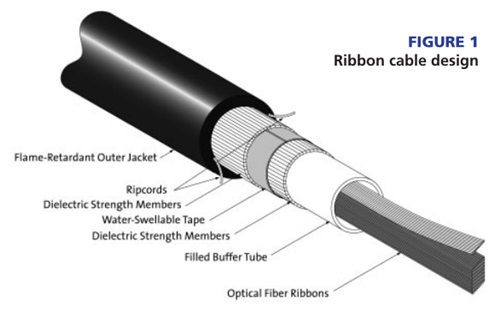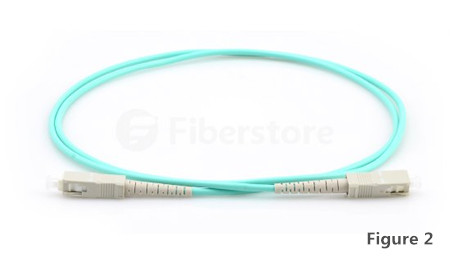Data center backbones are migrating to higher cabled fiber counts to meet the increasing system bandwidth needs. Network designers used to specify tight-buffered and loose-tube cable designs for these backbone applications. But in today’s networks, designers are turning to ribbon cable designs as they provide the highest connectivity density relative to cable size.
Ribbon Optical Cable Design
Ribbon optical cable has recently been a primary cable design choice for deployment in campus, building and data center backbone applications where you require at least 24 fiber counts. Compared to stranded loose tube cable and tight-buffered cable designs, the cable design offers robust performance and it provides the maximum fiber density relative to cable diameter.
Ribbon optical cable has recently been a primary cable design choice for deployment in campus, building and data center backbone applications where you require at least 24 fiber counts. Compared to stranded loose tube cable and tight-buffered cable designs, the cable design offers robust performance and it provides the maximum fiber density relative to cable diameter.
This cable design characteristically consists of 12 to 216 fibers organized inside a central tube. The 12-fiber ribbons are readily accessible and identifiable with ribbon identification numbers and TIA-598 compliant fiber color coding. For indoor application, it used specially formulated flame-retardant outer jackets, which allow the cable design to meet the requirements of the NFPA-262 flame test for ribbon plenum cables and the requirements of the UL-1666 flame test for ribbon riser cables. Like the stranded loose tube cable, completely gel-free designs are available. See Figure 1.

Ribbon Optical Cable Termination
For many years, ribbon optical cables are not specified in data center by designers and installers because 12-fiber ribbon field terminations were limited. But with the introduction of innovations such as ribbon splitting tools, ribbon furcation kits and field-installable 12-fiber array connectors, we can now easily terminate 12-fiber ribbons with simplex and duplex connectors such as LC or SC connectors or with the MTP connector. Take SC to SC fiber patch cable as an example, it is terminated with SC connectors on each ends. Figure 2 shows a SC to SC multi-mode fiber patch cable.
For many years, ribbon optical cables are not specified in data center by designers and installers because 12-fiber ribbon field terminations were limited. But with the introduction of innovations such as ribbon splitting tools, ribbon furcation kits and field-installable 12-fiber array connectors, we can now easily terminate 12-fiber ribbons with simplex and duplex connectors such as LC or SC connectors or with the MTP connector. Take SC to SC fiber patch cable as an example, it is terminated with SC connectors on each ends. Figure 2 shows a SC to SC multi-mode fiber patch cable.

We can use these high-density connectors to significantly accelerate the network cabling process, minimize errors and reduce congestion in patch panels. MTP connector is commonly available in preterminated form; either in pigtail form for splicing onto a 12-fiber ribbon or as an MTP connector backbone assembly terminated on each end. Field-installable MTP connectors are also available with the no-epoxy, no-polish design feature that allows termination of 12 fibers in less than five minutes. The MTP connector is specified to conform to the TIA/EIA-604-5 intermatability standard.
Ribbon Optical Cable Deployment
There are two methods to deploy MTP connectorized ribbon cables. The first method involves using an MTP connector module or cassette. An MTP connector module is a small metal or plastic housing that encloses a harness which has an MTP connector on one end and single fiber connectors (typically SC or LC) on the other end like a LC-SC fiber patch cable. This module provides a convenient and protective means of providing a break-out of the 12 fibers. When using this MTP connectorized ribbon cable deployment method, testing the system to verify the optical performance is just as simple and straight forward as any traditionally installed system. A simple link-loss test using a one-jumper reference is all you’ll require.
Ribbon Optical Cable Deployment
There are two methods to deploy MTP connectorized ribbon cables. The first method involves using an MTP connector module or cassette. An MTP connector module is a small metal or plastic housing that encloses a harness which has an MTP connector on one end and single fiber connectors (typically SC or LC) on the other end like a LC-SC fiber patch cable. This module provides a convenient and protective means of providing a break-out of the 12 fibers. When using this MTP connectorized ribbon cable deployment method, testing the system to verify the optical performance is just as simple and straight forward as any traditionally installed system. A simple link-loss test using a one-jumper reference is all you’ll require.
The second method to deploy MTP connectorized ribbon cable involves using an MTP inter-connect. In this method, an MTP connectorized harness cable is plugged into the front of the panel. This MTP connectorized harness is a ribbon interconnect cable terminated with MTP connectors on both ends, or can be terminated with single fiber connectors on one end. The other end of the harness is typically run to a network device or to a patch panel. This method of deployment for applications will use parallel transmissions, such as Infiniband. Because there is no module with single fiber connectors to plug into for testing, there is a method to test the MTP connectorized ribbon cable link. This link-loss test method uses a 3-jumper reference. We’ve outlined the link-loss test method for MTP connectorized ribbon cables without modules below.
Summary
Ribbon optical cable is now gradually taking place of stranded loose tube and tight-buffered cable and being deployed in areas where they have historically been used. Preterminated or field-terminated ribbon cable is now easily obtained using traditional simplex or duplex connectors as well as MTP Connectors. Fiberstore provides a large variety of fiber optic cables terminated with SC, LC, MTP cables. They all can be customized to meet your special needs.
Ribbon optical cable is now gradually taking place of stranded loose tube and tight-buffered cable and being deployed in areas where they have historically been used. Preterminated or field-terminated ribbon cable is now easily obtained using traditional simplex or duplex connectors as well as MTP Connectors. Fiberstore provides a large variety of fiber optic cables terminated with SC, LC, MTP cables. They all can be customized to meet your special needs.

Thanks for sharing structured cabling companies in dubai
ReplyDelete